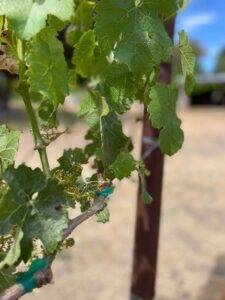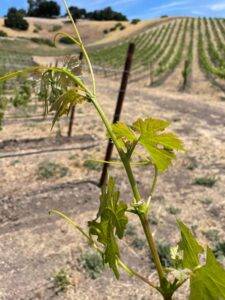This month has revolved a lot around canopy management practices and getting the vines ready to produce quality fruit!
Canopy Management: Suckers & Shoots
The Vineyard Team has been busy removing all the suckers from the trunk of the vines. Suckers are exactly what the name implies – they’re extra weeds or even vines forming from the rootstocks of the vine that take (or suck) water and nutrients away from the main vine. The less suckers that are around the vine, the less competition there is to get all the water and important nutrients needed.
The rest of the focus was on shoot thinning. The vineyard team went out and made sure to cut back the shoots to set them up for the rest of the season. Ideally we want two buds for prunning and two shoots per spur.
We are Officially in Bloom!
The flowers have bloomed and the next step is to self-pollinate. The flowers will then be replaced by berries. Fun fact… Vines are asexual, meaning they have both the male and female parts needed to propagate. This means that although bees are needed for cover crops and so many other moving parts in our vineyard, vines do not need to rely on insects or the spreading of seeds to pollinate.
Canopy Management : Disease Prevention – organic & safe
Now is an important time in the vineyard to spray to protect the vines against diseases – especially powdery mildew- the most common fungal disease around this area and most wine growing regions. We will be using a fungicide to spray against powdery mildew and spraying sulfur and other micronutrients beneficial for the vines.


Testing, testing… 1, 2, 3
Bloom is a very important time for vineyard management. This is the ideal time for vintners to test the nutrient levels of the vines and see if there are any deficiencies and then to fertilize. To do this, we sample the petioles – the piece that connects the leaf blade to the shoot (the stem). In bloom, we test the petioles that are growing opposite of the clusters that are forming. We then send those back to the lab for nutrient analysis. Some important macro and micro nutrients we are looking out for during this time are Nitrogen, Potassium, Zinc, and Boron – all common deficiencies in California vineyards.
What’s to come…
Aside from canopy management and making sure the vines are getting the correct nutrients, the coming month we will be awaiting fruit set around July – the very first for our Armaa.N Vineyard! Summertime vineyard practices really do set the tone for the year’s harvest. We are that much closer to our first harvest here at LXV.
We can’t wait to share with you what is to come from our Vineyard. Patience is definitely a virtue in the wine industry.


